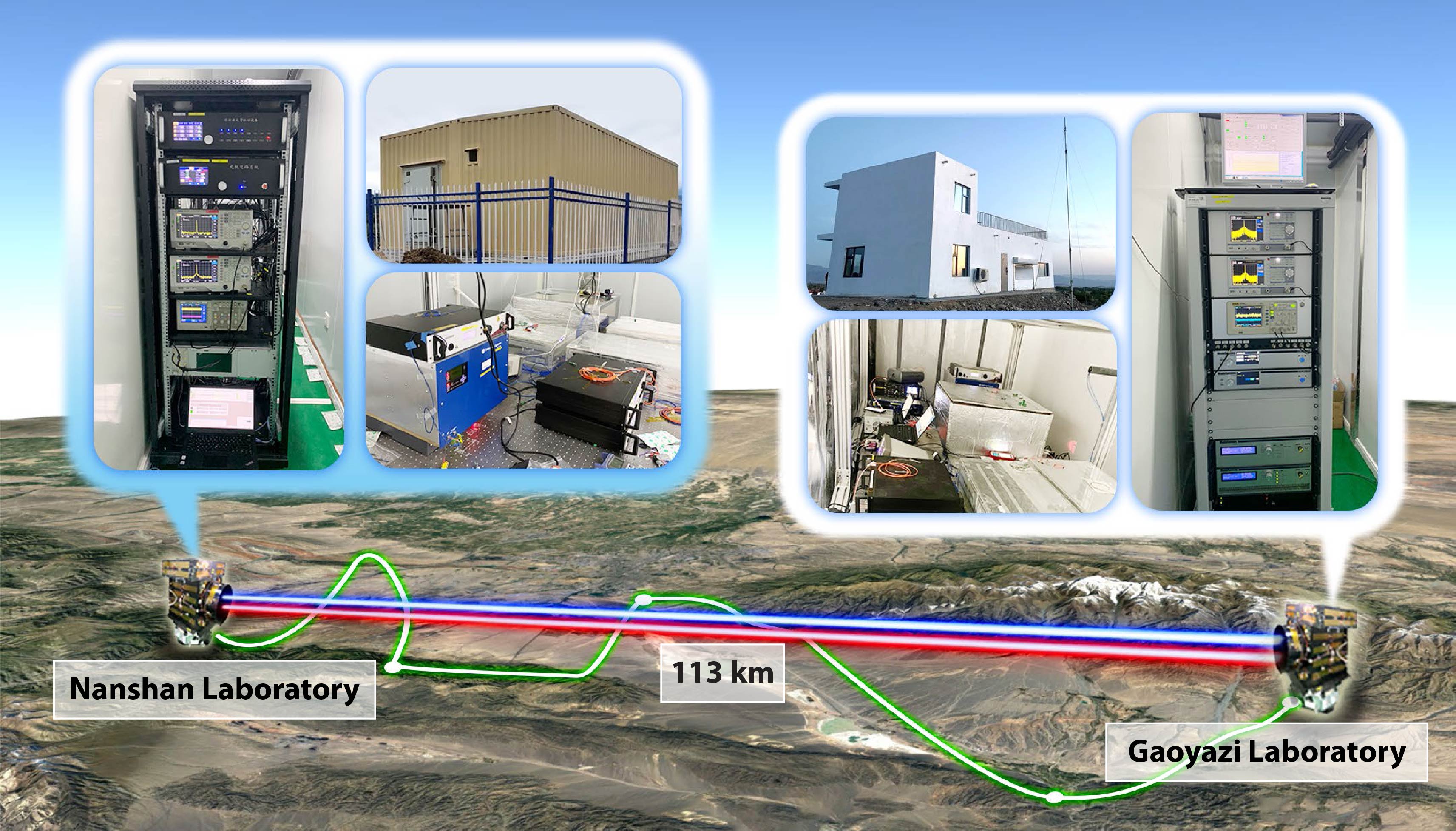Menlo Systems product:

FC1500-ULN Optical Frequency Combs
Laser light keeps clocks in step
There is something very odd about time. There are hours that seem to pass in a trice, while others appear to last for ages. Time is not only hard to fathom, the synchronization of time signals is an extremely difficult undertaking – in particular, when such signals must be transmitted over long distances under challenging conditions. However, laser technology now offers a way to simplify the synchronization of clocks that are very far apart, as demonstrated by scientists led by physicist Jian-Wei Pan at the University of Science and Technology of China in Hefei. With the aid of pulsed laser light, the team based in the province of Xinjiang has succeeded in synchronizing the ticking of two optical clocks over a distance of 113 km in free space. This represents an improvement of seven-fold over the previous record (16 km). The whole system including two extremely low-noise FC1500-ULN frequency combs manufactured by Menlo Systems, two home-made extremely low noise frequency combs, state-of-the-art homemade amplification systems, highly stable optical transmitter-receiver systems, and an efficient optical sampling strategy.
When Albert Einstein was asked to define the concept of time, he had a ready answer: “Time is what the clock says.” Unfortunately, as we all know, clocks have an inveterate tendency to diverge from one another, and precise synchronization of the ticking of distantly located clocks is by no means a trivial task. How then can clocks be synchronized over long distances – irrespective of variations in atmospheric conditions – with the level of accuracy required by our worldwide communications, data transmission and navigation systems? How can the most precise timing devices on the planet be linked together without degrading their accuracy?
Networks of optical clocks are not only at the heart of navigational systems, they are a crucial factor in the upcoming redefinition of the second and play a vital role in gravitational measurements. The current time standard relies on the atomic cesium clock, the ticking rate of which is based on the frequency of a specific microwave transition. Today‘s optical clocks make use of an optical transition in elements such as strontium and ytterbium as their fundamental unit of time. These clocks therefore tick at a rate that is 100,000 times faster than that of the best cesium clocks. This allows time to be sliced into much shorter intervals, and enables modern optical clocks to attain a frequency stability of one part in 1019. In order to synchronize such clocks in a network, the time information must be transmitted between them at the same ultrahigh frequency. This is where light, with oscillation frequencies on the order of several hundred THz, comes into play. Light signals in this frequency band can be propagated over distances of many hundreds of kilometers via underground glass-fiber links. However, reliable optical transmission of data through free space poses a variety of challenges, and the technology is still in its infancy.

Figure: Overview over the 113 km signal transfer path with home-built OFC systems at 1570 nm (left inset) and Menlo Systems OFC systems at 1540 nm (right inset) for the two free space channels, both OFC types operating at each lab. The fiber transfer channel is indicated in green.
Jian-Wei Pan and his colleagues at the University of Science and Technology of China, have now used pulsed laser light transmitted through the atmosphere to successfully synchronize two optical clocks that were 113 km apart (see figure). In doing so, they broke the previous record for free-space transmission by almost 100 km.
Because molecules present in the atmosphere either absorb or scatter the radiation, transmission of optical signals in the near-infrared region of the spectrum through the air is less efficient than the propagation of longer wavelengths, such as those in the infrared or radio bands. This has the effect of markedly reducing the strength of the signal that reaches the detector. Up to now, physicists have compared optical clock rates by transmitting the necessary signals through glass-fiber cables. But if the ultimate aim is to create a global communications network based on optical clocks, this approach soon reaches its limit.
Pan‘s group was able to generate, amplify and propagate signals in the near-infrared waveband that were sufficiently stable to be successfully transmitted to the distant receiver, despite considerable degradation during their passage through the atmosphere. The researchers produced the signals with the aid of optical frequency combs (OFCs). Pan’s group used two of the FC1500-ULN instruments fabricated by Menlo Systems and two home-built OFCs as the basis for the setup of the comb-based link. In order to compensate for the high signal losses during passage through free space, they constructed their own highly efficient two-stage erbium-doped fiber amplifiers (EDFAs), and connected them directly to the output ports of the comb oscillators. After filtering the optical signal to a bandwidth of 20 nm, they were able to increase its power to a level of 1 W. This was one of the major technical improvements that has been developed in the course of this work, which helped to ensure the success of the experiment. In addition, the team optimized the performance of the receivers to enable them to detect the very weak incoming signals and automatically track the direction of the incoming laser beam.
In order to assess the stability of the system, the team transmitted the time signals at two slightly different wavelengths in the near-infrared, as well as sending a further timing signal via a glass-fiber link. By comparing the minuscule differences between the signals detected by the receiver, the researchers were able to show that the ticking rate could be transmitted with a level of stability equivalent to a deviation of one second in 80 billion years. This degree of precision corresponds to that expected of optical clocks.
Nevertheless, several hurdles must be overcome before optical signal transmission in free space can be regarded as a mature technology. For one thing, the present experiment was carried out under essentially optimal atmospheric conditions. In urban environments, the higher levels of humidity and air turbulence would result in much greater signal loss. However, these losses reach their peak near ground level, and in the case of vertical signal transmission the reduced density of the upper air will have a positive effect. So the team is confident that their strategy provides a promising foundation for satellite-based optical dissemination of time signals, and represents an important step on the route to a global signaling and synchronization network.
On the basis of this novel technology, it should be possible to synchronize optical clocks located in space with timepieces on Earth. They are convinced that their work paves the way for the future distribution of time and frequency information via satellite. Thanks to the combination of long-distance links based on OFCs and glass-fiber networks, the instabilities associated with short averaging times could be ameliorated by the careful management of dispersion in the combs and terminal fiber links, which would enhance the precision of timing. With the help of such synchronization, it would be possible to provide new probes for fundamental physics, such as hunting for dark matter and detecting gravitational waves.
Author: Thorsten Naeser
Original publication:
Q. Shen, J.-Y. Guan, J.-G. Ren, T. Zeng, L. Hou, M. Li, Y. Cao, J.-J. Han, M.-Z. Lian, Y.-W. Chen, X.-X. Peng, S.-M. Wang, D.-Y. Zhu, X.-P. Shi, Zh.-G. Wang, Y. Li, W.-Y. Liu, G.-Sh. Pan, Y. Wang, Zh.-H. Li, J.-C. Wu, Y.-Y. Zhang, F.-X. Chen, Ch.-Y. Lu, Sh.-K. Liao, J. Yin, J.-J. Jia, Ch.-Zh. Peng, H.-F. Jiang, Q. Zhang, & J.-W. Pan:
Free-space dissemination of time and frequency with 10−19 instability over 113 km
Nature 610, pages 661–666 (2022)
DOI: https://doi.org/10.1038/s41586-022-05228-5